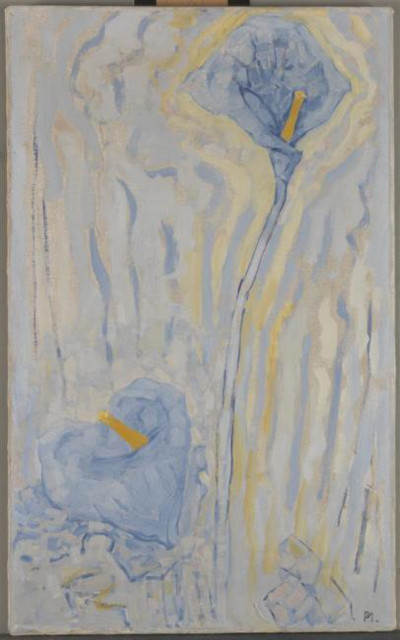Lilies are a popular choice for artists, thanks to their unusual form and also some of the bright colours that they include. Here we find Mondrian capturing two arum lilies in a fairly loose, expressive artwork which feels more like a brisk study piece than a fully completed oil painting.
The artist carefully distributes the two flower heads into alternative corners of the composition with one of the stems stretching across the area in between. Mondrian does not go into precise detail here, but just focuses on creating his own interpretation of what he saw in front of him at the time. He would have carefully placed these flowers himself in order to get just the layout that he desired, which is one of the advantages of still life work. He may not have been famous for his work within this genre, but Mondrian did achieve success over a period of several years by focusing on still life artworks in which he developed elements of his technical skills and also broadened his overall oeuvre. Mondrian would also take landscape and portrait art into his career in the early stages as he attempted to find his particular calling - eventually it would turn out to be abstraction. He may well have taken inspiration from a number of 19th century artists who were not only happy to include flowers within their work, but some even went as far as becoming keen gardeners and growing flowers specifically for the purpose of including them in still life artworks.
This painting is 80cm tall by 50cm wide. It is dated at circa 1917, and therefore comes much later than the artist's other flower paintings. Two Arum Lilies was within a private collection for many years before being bequethed to the Kunstmuseum Den Haag, which is one of the most famous art galleries in the Netherlands. Sal Slijper was well acquainted with the artist himself and requested this painting specifically. He would later donate it to the gallery after allowing it to be displayed there for many years previously. He commissioned Mondrian several times and so counted a good number of his paintings within his collection by the time the artist's career came to an end.
Mondrian liked to sketch some of his ideas out first before starting the main oil painting and would also sometimes produce oil sketches, which are essentially oil paintings but with a greatily reduced level of detail. These oil sketches would be a middle ground between pencil sketches as preparation, and then the fully completed oil painting. Artists like Renoir would often work in this manner and such is the level of fame that he continues to enjoy today that even these items would now be worth large amounts of money at auction. Much the same can be said for Mondrian, with around 700 paintings surviving from his career and all of them retaining a strong value, even if they diverge from the style and content that he was most famous for. One can also find still life experiments within most other oeuvres from the major artistic careers, with ambition normally leading to intrigue and a desire to master all the fundamental skills within painting.




